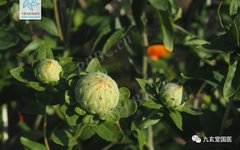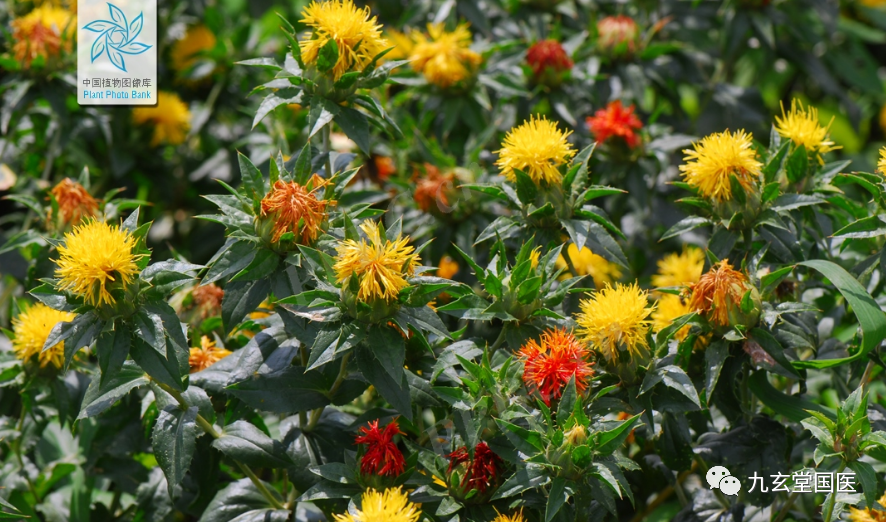
Alias: Zang Honghua (藏红花), Fan Honghua (番红花), Ci Honghua (刺红花).
Historical Origin: Honghua, also known as Red Flower, grows in Lianghan and the Western Regions. According to the Bo Wu Zhi (博物志), Zhang Qian obtained seeds from the Western Regions.
Source of Medicinal Material: The upper part of the flower column and stigma of the plant from the Asteraceae family, genus Carthamus.
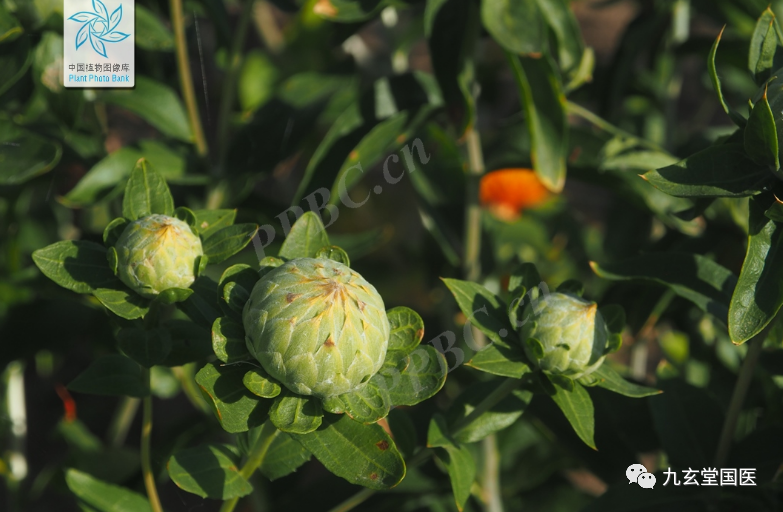

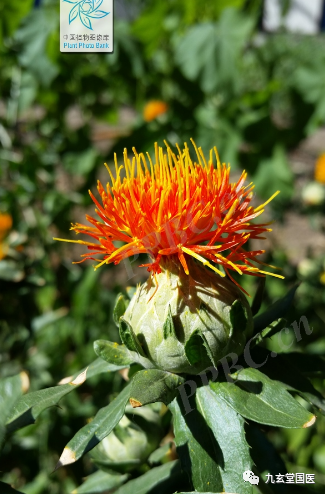
Plant Characteristics: Honghua is a perennial herb, growing 50-100 cm tall. The stem is erect, branched at the top, white or pale white, smooth and hairless. The leaves are alternate, sessile, lanceolate, ovate-lanceolate, or oblong-ovate, measuring 7-15 cm long and 2.5-6 cm wide, with large serrations, small serrations, or entire margins. The flowers are numerous, forming a corymb at the top of the stem, surrounded by bracts; the bracts are oval or ovate-lanceolate, with spines at the tips measuring 2.5-3 cm long. The inflorescence is 2.5 cm in diameter, with a total of 4 layers of bracts. The small flowers are red or orange, all bisexual, with a corolla length of 2.8 cm and a slender tube length of 2 cm. The achenes are obovate, measuring 5.5 mm long and 5 mm wide, white, with 4 angles and no pappus. The flowering and fruiting period is from May to August.
Habitat Distribution: Honghua prefers warm, dry climates, is cold-resistant, and tolerates poor soil. It is drought-resistant but sensitive to waterlogging, suitable for well-drained, moderately fertile sandy soils, with oil-sand and purple sandy soils being the most suitable. Seeds germinate easily, sprouting at temperatures above 5°C, with optimal germination temperatures of 15-25°C and a germination rate of about 80%. It has strong adaptability, with a life cycle of 120 days.
Resource Distribution: Originally from Central Asia, it is found wild in the Soviet Union and cultivated in Japan and Korea. In China, it is cultivated in Henan, Xinjiang, Gansu, Shandong, Zhejiang, Sichuan, and Tibet. In addition to these regions, wild populations can also be found in Shanxi, Gansu, and Sichuan.
Harvesting: Flowers bloom in late May, with peak flowering from late May to mid-late June, harvested in batches. Harvest on sunny days, between 6-8 AM, when the tubular flowers are fully opened and golden yellow. If harvested too late, the flowers wilt and turn red-black, making harvesting difficult and reducing quality and yield. After harvesting, dry in the shade or use low-temperature drying at 40-60°C.
Shizhen states: Honghua can be sown in February, August, and December, after rain, similar to sowing hemp. The tender leaves and seedlings can also be eaten. Its leaves resemble those of small thistles. By May, it blooms, resembling large thistle flowers but red. Harvest the flowers in the morning, crush them, wash with water, and strain the yellow juice, then crush again with sour millet wash and strain again, covering with Qinghao (青蒿) overnight, then dry in the sun. Alternatively, it can be made into thin cakes and dried in the shade.
Cultivation: Prefers warm, dry climates, is cold-resistant, drought-resistant, salt-alkali tolerant, and can grow in thin soils. The optimal germination temperature is 25°C, and seedlings can tolerate -5°C. In the south, autumn sowing has a growth period of 200-250 days, while in the north, spring sowing has a growth period of 120 days. It is best cultivated in sunny, warm, deep, moderately fertile, well-drained sandy loam. Avoid continuous cropping, and prevent waterlogging during flowering. Previous crops should preferably be legumes or grasses, and it can be intercropped with vegetables.
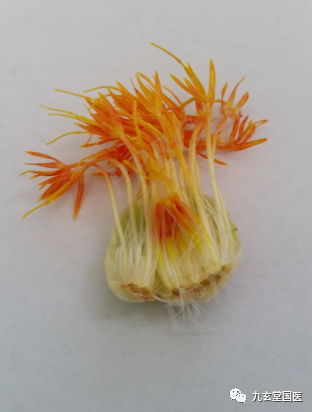


Identification of Characteristics: The tubular flowers without ovaries are 1-2 cm long, with a surface that is reddish-yellow or red. The corolla tube is slender, with 5 lobes at the tip, and the lobes are narrow and 5-8 mm long. There are 5 stamens, and the anthers are tubular, yellowish-white. The style is long and cylindrical, with a slightly bifurcated tip. The texture is soft, with a faint fragrance and a slightly bitter taste.
Quality is best when the corolla is long, red, bright, and soft without thorns.
Pharmacological Effects: 1. Effects on the uterus 2. Effects on the circulatory system
Processing: Remove impurities and yellow hairs.
Taste and Properties: Pungent, warm.
1. Kaibao Bencao (开宝本草): “Pungent, warm, non-toxic.”
2. Tangye Bencao (汤液本草): “Pungent, sweet, warm, bitter.”
Meridian Affinity: Enters the Heart and Liver meridians.
1. Leigong Paozhi Yao Xing Jie (雷公炮制药性解): “Enters the Heart and Liver meridians.”
2. Bencao Jing Jie (本草经解): “Enters the Foot Jueyin Liver meridian and Hand Taiyin Lung meridian.”
3. Bencao Zai Xin (本草再新): “Enters the Liver and Kidney meridians.”
Main Functions and Indications: Invigorates blood circulation, regulates menstruation, removes blood stasis, and alleviates pain. Treats amenorrhea, dysmenorrhea, masses, difficult labor, stillbirth, postpartum lochia retention, pain from blood stasis, trauma, and swelling.
Dosage: Internal use: decoction, 3-9 g; in powder or tincture form, fresh ones can be juiced. External use: ground into powder and sprinkled.
Precautions: Use with caution in pregnant women.
Various Discussions: 1. Tang Bencao (唐本草): Treats locked jaw, blood clots, and various postpartum diseases.
2. Kaibao Bencao (开宝本草): Treats postpartum blood stasis, locked jaw, abdominal pain from retained blood, stillbirth, and can be taken with wine. Also treats toxic blood loss.
3. Bencao Meng Quan (本草蒙筌): Treats throat obstruction and choking.
4. Gangmu (纲目): Invigorates blood, moistens dryness, alleviates pain, disperses swelling, and regulates menstruation.
5. Bencao Zheng (本草正): Treats blood heat from measles and stagnant blood that does not disperse.
6. Bencao Zai Xin (本草再新): Promotes urination, reduces swelling, stabilizes pregnancy, and treats stillbirth.
7. Bencao Yanyi Buyi (本草衍义补遗): Honghua breaks blood stasis and nourishes blood. Excessive use breaks blood, while small amounts nourish blood.
8. Bencao Jing Shu (本草经疏): Honghua is a key medicine for blood circulation. It treats postpartum blood dizziness and locked jaw due to retained blood not descending, which causes dizziness and locked jaw. It enters the Heart and Liver, promoting the downward movement of retained blood, thus stopping dizziness and locked jaw. Abdominal pain is due to retained blood not dispersing, and stillbirth requires blood circulation. Honghua is primarily a blood-moving medicine; it resolves blood stasis and promotes circulation, but excessive use can lead to uncontrolled bleeding.
9. Bencao Hui Yan (本草汇言): Honghua is a medicine that breaks blood stasis, moves blood, harmonizes blood, and regulates blood. It treats various diseases in women related to blood issues, such as blood dizziness, locked jaw, and abdominal pain from retained blood. It is essential for treating various conditions during labor, and it cannot be replaced by any other herb. Conditions like amenorrhea, abdominal pain with purple-black discharge, trauma, and skin lesions are all due to disharmony of Qi and blood, which Honghua can regulate.
10. Yaopin Huayi (药品化义): Honghua is effective in promoting meridian circulation and is a Qi medicine in the blood, capable of both purging and tonifying. If used in excess, it can be too pungent and warm, causing blood to disperse. It can be combined with other herbs like Su Mu to break blood stasis, and with Rou Gui to regulate menstruation. It can also be used with Bai Shao and other herbs to treat systemic or abdominal blood stasis pain. The dosage is crucial for achieving the desired effects.
Compatibility:
1. Honghua and Taoren (桃仁): Both have the function of invigorating blood circulation and removing blood stasis. Honghua is warmer and more effective in alleviating pain, while Taoren is more effective in breaking blood stasis. Together, they can treat amenorrhea, abdominal pain from blood stasis, and various blood stasis-related pains.
2. Honghua and Chuanxiong (川芎): Both can invigorate blood circulation. Honghua removes blood stasis and regulates menstruation, while Chuanxiong is good at promoting blood circulation and alleviating pain. Together, they are effective for blood stasis-related amenorrhea and systemic pain due to blood stagnation.
3. Honghua and Sumu (苏木): Both can invigorate blood circulation and remove blood stasis, and both have the principle of “less use invigorates blood, more use breaks blood.” Honghua is more focused on moving blood, while Sumu is better at breaking blood stasis. Together, they enhance the effects of blood circulation and stasis removal, commonly used for blood stasis-related amenorrhea and trauma.
4. Honghua and Yimucao (益母草): Both have the effect of invigorating blood and dispersing stasis. Adding Shan Zha (山楂) enhances their effects. They can treat abdominal pain from blood stasis and postpartum lochia retention.
5. Honghua and Zicao (紫草): Honghua invigorates blood, while Zicao cools blood and disperses rashes. Together, they can treat measles with difficult rashes. They can also be used to alleviate pain and swelling, often combined with Danggui (当归) and Mudanpi (牡丹皮).
Additional Formulas:
1. For women with obstructed menstruation due to blood stasis: Honghua (细擘), Sufangmu (捶碎), and Danggui in equal parts. Finely chop, use 1 liang with 1.5 liters of water, first decoct the flowers and wood, then add a cup of wine and Danggui, decoct again, and take warm before meals. (Zhu Shi Ji Yan Yi Fang (朱氏集验医方))
2. For febrile diseases with stillbirth: Honghua boiled in wine, drink 2-3 cups. (Furen Liangfang Buyi (妇人良方补遗))
3. For retained placenta: Honghua boiled in wine, drink 2-3 cups. (Chanru Ji Yan Fang (产乳集验方))
4. For women with various wind conditions and abdominal pain from blood stasis: Honghua (红蓝花) 1 liang. Use 1 large sheng of wine, decoct until reduced by half, take half at once, and repeat if symptoms persist. (Jinkui Yaolue (金匮要略) Honghua wine)
5. For all types of swelling: Honghua, crushed and juiced. (Wai Tai Mi Yao Fang (外台秘要方))
6. For throat obstruction and choking: Honghua juice, 1 small sheng, take as needed. If no fresh flowers are available in winter, soak dried ones to extract juice. (Haishang Ji Yan Fang (海上集验方))
7. For chronic ear discharge: Honghua 1 fen, Bai Fan (白矾) 1 liang (burnt to ash). Grind into fine powder and use a small amount in the ear. (Sheng Hui Fang (圣惠方))
8. For trauma and wall injuries: Chuanma 1 fen, Muxiang 2 fen, Honghua 3 fen, Gancao 4 fen. All used raw, ground into powder, and taken with yellow wine. (Jijiu Bian Fang (急救便方))
9. For bedsores: Honghua in appropriate amount, soaked in wine for external application. (Yunnan Zhongcaoyao (云南中草药))

